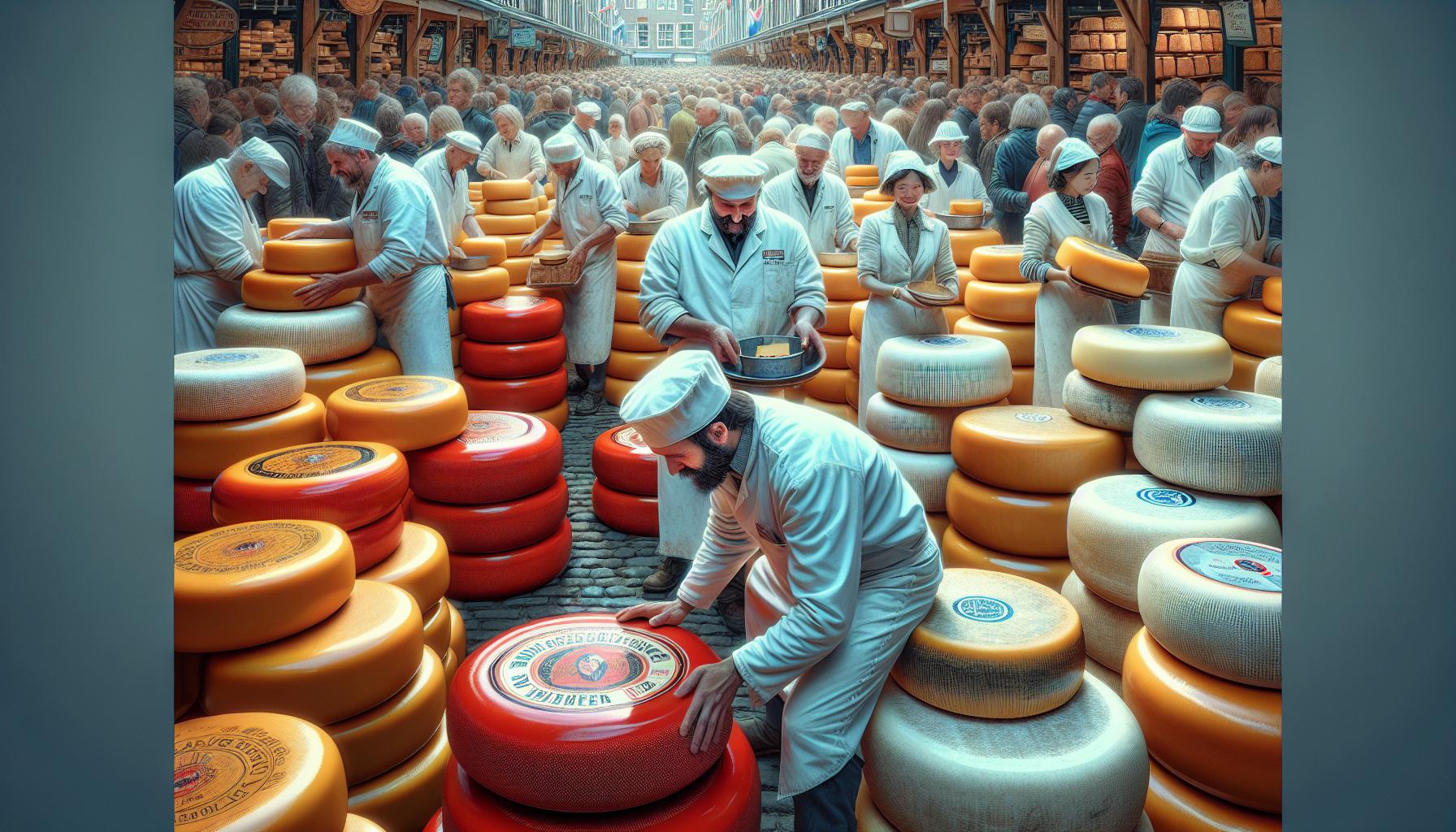Netherlands food culture might not be as famous as its European neighbors but it’s packed with hearty comfort foods and unique flavors that tell stories of the Netherlands’ rich maritime history. From crispy bitterballen to sweet stroopwafels the Dutch food scene offers a delightful mix of traditional and modern culinary experiences.
Netherlands food culture reflects the nation’s practical and straightforward approach to life. While the locals love their “stamppot” (mashed potatoes with vegetables) during cold winter months they’ve also embraced global influences creating a diverse food landscape in cities like Amsterdam and Rotterdam. What’s even more fascinating is how the Dutch have mastered the art of street food making tasty treats accessible at any time of day.
Netherlands Food Culture
Netherlands food culture follow a structured approach with specific meal times that reflect the country’s agricultural heritage. The daily routine emphasizes practical nutrition combined with social gatherings around food.
Daily Meal Structure
Dutch breakfast starts between 6:00-8:00 AM with bread slices topped with cheese butter or hagelslag (chocolate sprinkles). Lunch occurs from 12:00-2:00 PM featuring open-faced sandwiches called “broodjes” with various toppings. The main hot meal “avondeten” takes place between 5:00-7:00 PM consisting of meat potatoes vegetables. Coffee breaks “koffietijd” happen at 10:30 AM 3:00 PM accompanied by cookies or small treats. Dinner portions remain moderate with separate plates for each component.
| Meal Time | Dutch Name | Typical Components |
|---|---|---|
| 6-8 AM | Ontbijt | Bread cheese hagelslag |
| 12-2 PM | Lunch | Broodjes sandwiches |
| 5-7 PM | Avondeten | Meat potatoes vegetables |
The Dutch Love for Dairy
The Netherlands ranks among the top dairy consumers globally with an average consumption of 341 kilograms per person annually. Dutch dairy culture centers around cheese production particularly Gouda Edam Leyden varieties. Milk products appear in multiple daily meals including breakfast coffee breaks afternoon tea. Traditional dairy items include vla (custard) karnemelk (buttermilk) yogurt quark. Local cheese shops “kaaswinkel” offer extensive selections of aged young specialty cheeses.
| Dairy Product | Annual Consumption (kg/person) |
|---|---|
| Cheese | 21.6 |
| Milk | 195.3 |
| Yogurt | 124.1 |
Most Popular Dutch Dishes

Netherlands food culture features distinctive dishes that combine simple ingredients with rich flavors reflecting the country’s cultural heritage.
Stamppot and Winter Comfort Foods
Stamppot stands as the Netherlands’ quintessential comfort food, combining mashed potatoes with various vegetables. Traditional variations include boerenkool (kale) stamppot, hutspot (carrots and onions) stamppot, and zuurkool (sauerkraut) stamppot. Each version comes topped with a smoked sausage called rookworst, gravy, and crispy bacon bits. The dish originated in the 16th century when potatoes became a staple food source during harsh winters. Dutch families gather around stamppot during cold months, making it a symbol of home cooking and warmth.
Street Food Favorites
Dutch street food culture centers around quick, satisfying snacks available from food stalls and vendors. Herring stands serve raw herring with chopped onions, eaten by holding the fish by its tail and lowering it into the mouth. FEBO automat walls dispense hot snacks like krokets (croquettes filled with meat ragout) and frikandellen (deep-fried meat sausages). Poffertjes stalls create miniature fluffy pancakes topped with butter and powdered sugar. Food trucks offer traditional bitterballen (deep-fried beef croquettes) served with mustard. These street foods represent Dutch culinary innovation and practicality.
The Art of Dutch Cheese Making

Dutch cheese making spans over eight centuries of craftsmanship, with cheesemakers combining traditional techniques with modern practices. The Netherlands produces more than 800 million kilograms of cheese annually, exporting products to over 130 countries.
Gouda and Edam Varieties
Gouda represents 60% of Dutch cheese production, featuring distinct aging periods that create unique flavors. Young Gouda (jong) matures for 4 weeks, delivering a mild buttery taste. Medium-aged Gouda (belegen) requires 4-6 months, developing a richer flavor profile. Aged Gouda (oud) matures for 10-12 months, producing crystalline structures with intense caramel notes. Edam cheese, recognizable by its red wax coating, offers a lower fat content of 40% compared to Gouda’s 48%. Traditional Edam ages for 17 weeks, creating a firm texture with a slightly salty taste.
Cheese Markets and Traditions
Historic cheese markets in Alkmaar, Gouda, Edam, Hoorn operate from April through September, preserving centuries-old trading customs. The Alkmaar market attracts 100,000+ visitors annually, featuring cheese carriers in traditional white uniforms performing ritualistic weighing ceremonies. Traditional cheese trading involves a unique hand-clapping negotiation system called “handjeklap,” where buyers haggle with sellers through a series of hand slaps. The market’s cheese masters assess quality using specialized tools, including a cheese iron for sampling cores from wheels weighing 12-16 kilograms each.
Dutch Snacking Culture

Dutch snacking habits center around social gatherings with small, shareable bites available throughout the day. The Netherlands embraces a diverse range of snacks that complement different occasions from casual meetups to formal celebrations.
Borrelhapjes and Social Gatherings
Borrelhapjes form the cornerstone of Dutch social gatherings, especially during afternoon drinks called “borrel.” These savory snacks include deep-fried bitterballen filled with beef ragout, kaassoufflés containing molten cheese, and mini frikandellen served with mustard. Tables at Dutch gatherings feature plates of aged cheese cubes, sliced sausage varieties, and crispy toast rounds topped with various spreads. Small bowls of mixed nuts, particularly peanuts served with spicy curry-flavored mayonnaise called “satésaus,” appear at most gatherings. Traditional borrelhapjes platters incorporate raw vegetables with herb dip, pickled onions, and Amsterdam onions preserved in vinegar.
Sweet Treats and Pastries
Dutch sweet snacks showcase the country’s mastery of pastry making. Stroopwafels lead the lineup with their caramel syrup filling between two thin waffle cookies. Bakeries display rows of tompouce, pink-glazed pastries filled with vanilla cream. Oliebollen emerge during winter months as deep-fried dough balls dusted with powdered sugar. Poffertjes stations dot city streets, serving mini pancakes topped with butter and powdered sugar. Local markets offer speculaas cookies spiced with cinnamon, nutmeg, and cloves. Hagelslag, chocolate sprinkles on buttered bread, serves as a beloved morning or afternoon treat.
Modern Dutch Food Scene
The Netherlands food culture has evolved significantly over the past two decades. Contemporary Dutch cuisine combines traditional elements with innovative cooking techniques, sustainable practices and global influences.
International Influences
Global flavors shape modern Dutch dining through immigrant communities and international trade connections. Indonesian restaurants offer rijsttafel feasts with up to 40 small dishes, while Surinamese eateries serve roti and pom across major cities. Turkish döner kebab stands populate urban streets, and Moroccan tagines feature on restaurant menus. Asian fusion establishments blend Dutch ingredients with Far Eastern cooking techniques. Food halls like Rotterdam’s Markthal and Amsterdam’s Foodhallen showcase diverse international cuisines under one roof.
Farm-to-Table Movement
Dutch restaurants embrace local sourcing through partnerships with nearby farms and producers. Organic markets connect consumers directly with farmers who supply seasonal vegetables, fruits and dairy products. Restaurant menus change quarterly to feature ingredients at peak freshness. Urban farming initiatives transform city rooftops into productive growing spaces that supply fresh herbs and produce. Leading chefs champion sustainable agriculture by highlighting heirloom varieties of vegetables in their dishes. Food festivals celebrate regional specialties and connect diners with local food artisans. Agricultural tourism allows visitors to experience Dutch farming practices firsthand through farm stays and harvest activities.
Sustainability in Dutch Cuisine
The Netherlands leads European sustainable food initiatives through innovative agricultural practices and waste reduction programs. Dutch cuisine embraces eco-conscious methods while maintaining traditional flavors and cooking techniques.
Local Ingredients
Dutch chefs prioritize seasonal produce from nearby farms, reducing transportation emissions and supporting regional agriculture. Local ingredients include greenhouse tomatoes from Westland, mushrooms from Limburg caves and North Sea seafood. Farmers markets in Amsterdam, Rotterdam and Utrecht connect consumers directly with producers, offering fresh vegetables, fruits and artisanal products. Urban farming initiatives provide 15% of produce consumed in major cities through rooftop gardens and vertical farming systems.
Eco-Friendly Practices
Dutch restaurants implement comprehensive recycling programs that convert 85% of food waste into compost and biogas. Leading establishments use energy-efficient equipment, reducing power consumption by 40% compared to traditional kitchens. The Netherlands boasts 125 certified organic restaurants that source ingredients from farms within a 50-kilometer radius. Food preservation techniques like fermentation and pickling minimize waste while creating distinctive Dutch flavors. Smart greenhouse technology reduces water usage by 90% while producing vegetables year-round. Dutch food manufacturers adopt sustainable packaging solutions, eliminating 60,000 tons of plastic annually.
An Essential Part of the Country’s Fabric
Netherlands food culture stands as a testament to the nation’s rich history maritime heritage and practical approach to daily life. From traditional comfort foods to innovative sustainable practices the Netherlands continues to evolve its culinary landscape while maintaining its distinctive identity. The blend of time-honored recipes street food culture and modern global influences creates a unique gastronomic experience that’s both deeply rooted in tradition and forward-looking.
The Dutch approach to food reflects their values of simplicity sustainability and social connection. Whether enjoying a traditional stamppot sharing borrelhapjes with friends or exploring contemporary food halls Dutch cuisine remains an essential part of the country’s cultural fabric.



